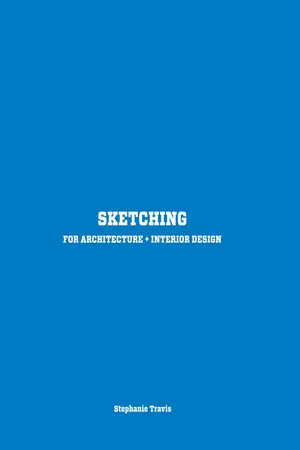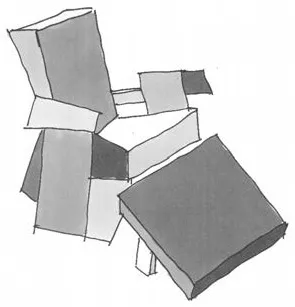![]()
1.
FURNITURE + LIGHTING
![]()
PRELIMINARY STUDY
The purpose of this exercise is to examine the overall form as well as the unique details of an object while exploring varied pen thicknesses. Understanding the quality and output of your thin, medium, and thick pens is important, as the pens become important communicators in the sketching process. In this example the light fixture has many interesting details, including its ability to be adjusted by rotating or tilting. These qualities are captured with quick studies that explore many different elements of the fixture.
1.
Select a light fixture Alternate between using your thin, medium, and thick pens to fill an entire sketchbook page with studies of your fixture. Move around the fixture to record what you can see from different angles. Zoom in to compelling details of a larger fixture.
2.
Using each pen (thin, medium, and thick), sketch the light fixture in its entirety.
LIGHTING SPECIFICATION
Tizio floor lamp
Richard Sapper I 2009
ABSTRACTION
This exercise uses abstraction as a sketching tool to examine the sculptural qualities of a chair. Simplifying the chair into a series of individual shapes helps you to understand the overall form more clearly. Note that the term shape refers to a two-dimensional element, such as a plane, while the term form refers to a three-dimensional element, such as a box. An abstraction study is an effective way to study an object, as it translates a complex form into flat, basic shapes and provides a thorough understanding of the design.
1.
Select three chairs Abstract each chair into simple shapes, similar to building blocks. With your markers, use varied intensities of gray (e.g. percentages of 10, 30, 50, 70, 90) to define each shape by rendering the planes with contrasting percentages. To render means to fill in. Rendered/filled in areas on an architectural drawing may also be referred to as poché. If a plane is rendered with 10 percent gray, use 30 percent or higher for the adjoining plane to provide contrast.
2.
Sketch the form of the chair, using your thick pen. A line drawing in a broad, heavy stroke emphasizes the unique form of the chair.
3.
While line drawings capture the overall form of an object, rendering the material conveys an additional layer of information. Add the materials of your chairs to your drawings. In this example the chairs on the left and center were designed using sheets of corrugated cardboard that are glued or laminated together, producing a linear texture. To express this texture a thin pen is used to represent the edges of the cardboard. As each layer of cardboard is very thin and the lines are close together, a medium pen would read too dark and dominate the sketch. The chair on the right comprises two-inch strips of maple wood that are bent and woven to create the form. Here a medium pen is used for both the outline and the woven texture, as the strips are significantly wider than the cardboard edges in the previous chairs.
CHAIR SPECIFICATIONS from left
Easy Edges chair
Frank Gehry I 1972
Wiggle chair
Frank Gehry I 1972
Cross Check chair
Frank Gehry I 1992
NEGATIVE STUDY
This exercise focuses on the space around and within an object, often referred to as negative space. Examining the voids that occur between individual elements of a larger object will help you to understand and sketch the object accurately. Continued practise using your three pens will help you to control your pen movement. A successful sketch is drawn with a fluid, confident line with the pen touching the paper. Avoid the mini-strokes that occur when a pen is lifted off the paper too many times while drawing a line. This creates a scratchy appearance that detracts from the drawing. Further use of your markers will provide more familiarity with t...







